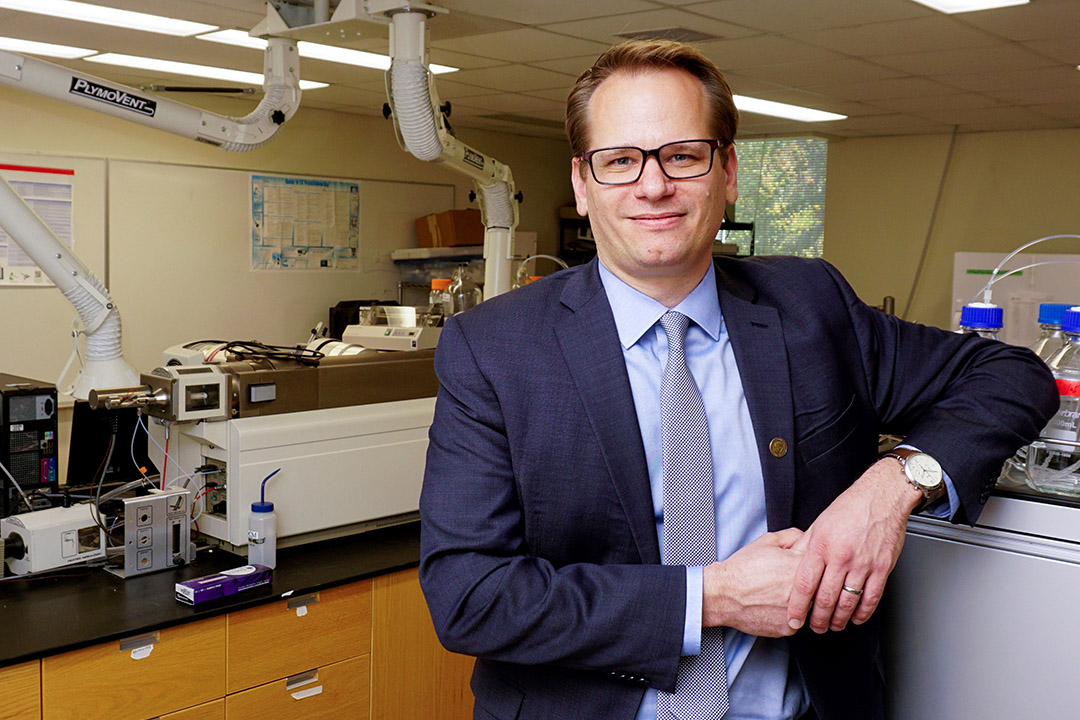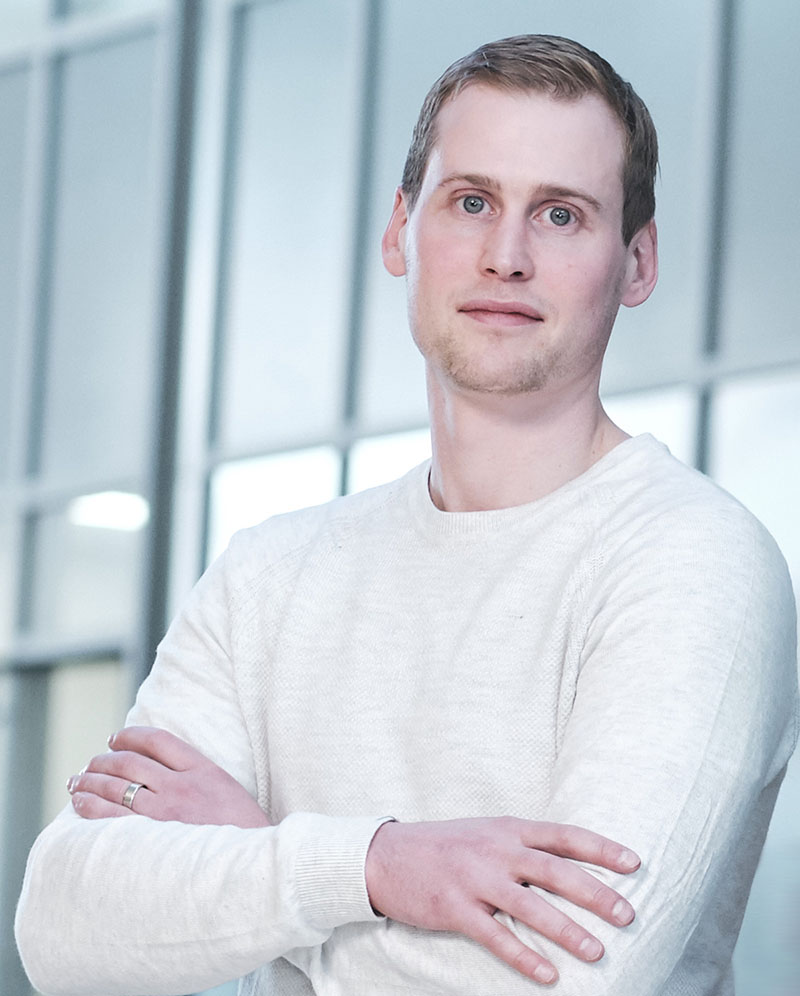
Award recognizes USask researcher’s commitment to the public good
Dr. Markus Brinkmann’s (PhD) internationally celebrated investigations into the compounds found in public waterways tell an important story about the health of humans and the environment, and are in-part why he has been awarded the James J. Morgan Early Career Award by the American Chemical Society (ACS) in the ACS Journal of Environmental Science & Technology (ES&T).
By Lindsay Herman, Research Profile and ImpactFrom a top journal in the field of environmental toxicology, this prestigious international award marks a significant accomplishment for Brinkmann, whose early career research is characterized by creative approaches, new ideas, and significant public impact.
Brinkmann was born and raised in Germany, where he completed his undergraduate and graduate degrees at RWTH Aachen University with a focus on aquatic toxicology. In 2009, he visited Canada on an undergraduate research trip to the University of Saskatchewan’s (USask) Toxicology Centre. Little did he know at the time, he would later lead groundbreaking research garnering significant public attention and receive one of the top international awards in his field.

Brinkmann now serves as the director of USask’s Toxicology Centre, an associate professor and the Centennial Enhancement Chair in Mechanistic Environmental Toxicology in the School of Environment and Sustainability (SENS), a faculty member in the Global Water Futures program, a member of USask’s Global Institute for Water Security, and the special advisor to the Vice-President Research on strategic partnerships with Germany.
Dr. Jonathan Challis (PhD), research scientist at Agriculture and Agri-Food Canada and past NSERC Banting Fellow at USask’s Toxicology Centre, was Brinkmann’s primary nominator for the award.
“His research interests are so vast and impressive. I don’t know where he finds the time, but his enthusiasm for the science only seems to grow,” said Challis. “He’s very deserving.”
Among Brinkmann’s many publications and contributions, the award honours two significant bodies of work that stand out for their scope of impact and commitment to the public good.
Uncovering the impacts of 6PPD-Quinone
For over a decade, researchers, environmentalists, and locals were equally puzzled and disturbed by the mass deaths of spawning coho salmon following rainstorms in the Pacific Northwest. Then, in 2020, researchers from the University of Washington published the discovery of a completely novel – and highly toxic – compound called 6PPD-Quinone. Examining an otherwise safe compound added to vehicle tires as an antioxidant, the researchers identified and detailed the specific transformations that occurred as tires wore down and created a uniquely toxic transformation product. During rainstorms, the chemical contained in this microscopic dust would spill into stormwater systems, significantly harming populations of local salmon.
Immediately following the publication of this groundbreaking study, Brinkmann and his colleagues from the USask Toxicology Centre revisited existing data analyzed from Saskatoon stormwater samples using a process known as ‘non-target chemical analysis’, or ‘high-resolution mass spectrometry.’ Brinkmann and colleagues were able to identify that 6PPD-Quinone was in fact present in all of their local samples. Brinkmann, with his team of collaborators and students, then worked to understand the mechanisms through which 6PPD-Quinone causes toxicity, and to evaluate its toxicity in other fish species.
“It’s one of the most toxic compounds that we’ve ever discovered,” said Challis. “There was no doubt in my mind that Markus was going to run with this. It’s a testament to how enthusiastic and dedicated he is to the science and the field.”
In the months that followed, Brinkmann and his team challenged notions by industry stakeholders that 6PPD-Quinone was a localized problem specific to select ecosystems and fish populations.
“We were the first to ever identify another species that is sensitive to 6PPD-Quinone beyond coho salmon, and now this has triggered a plethora of other papers that have done the same thing,” Brinkmann said. “Ours was the first study to show that, yes, this is more widespread and that there is inland relevance to this.”
Harnessing the infrastructure of USask’s Aquatic Toxicology Research Centre, Brinkmann and his colleagues identified the impact of 6PPD-Quinone on large-bodied and cold-water fish species such as rainbow trout, laying the foundation for similar research around the globe in the years to follow.
COVID-19 wastewater testing
Earlier that year, the COVID-19 pandemic was impacting communities around the world. While the novel virus swept across Saskatchewan, a lack of comprehensive public health data and infection rates further muddied the waters of public health messaging and policy.
“We sat at home during those lockdowns and thought, ‘Hey, how can we actually make ourselves useful?’” recalled Brinkmann.
Citing existing literature demonstrating that municipal wastewater could paint a picture of the health of the community from which it was sampled, Brinkmann and USask’s Drs. John Giesy (PhD) and Kerry McPhedran (PhD) leveraged connections with the City of Saskatoon and the wastewater treatment plant to collect and analyze local samples. By the fall of that year, with their methods and lab established, they began publishing weekly data sets on the presence of COVID-19 in local wastewater samples that were used to inform both public health measures and individual decision-making.
“I think we are oftentimes very hesitant to make decisions or implement tools under uncertainty,” said Brinkmann. “We had just started to get familiar with a method, and it takes quite a bit of courage to go out there and say, ‘You know what folks, we think we have a tool here. We think we have something that can help the community understand what’s going on with COVID, in the absence of good clinical testing data.’”
“The data really did have real-world implications. The amount of effort that went into creating the data and ensuring that the data was high quality and reliable was really, really critical,” recalled Challis. “It was an excellent example of Markus’ dedication to public good research. He’s a fantastic researcher, but he is also really effective at, and understands the importance of, communicating his research to the general public.”
In the years that followed, the team published weekly datasets to an online dashboard, engaged in over 300 media interviews and segments, and assisted in the roll-out of similar testing methods in municipalities and First Nations communities across Saskatchewan.
Research for public good
Brinkmann’s work, as celebrated by the James J. Morgan Early Career Award, is underscored by a deep commitment to bettering the health of the environment and society. Beyond discoveries and publications that contribute to the knowledge of those within his field, Challis noted that “[Brinkmann’s] engagement and his understanding of how important it is to communicate science to the general public is unique among academics.”
“He really understands the need to communicate this science to the public. He’s not just doing this for publications, he’s doing it because he cares about the environment and wants to protect it.”
Recognizing that his accomplishments were also the product of many supporting colleagues, post-doctoral fellows, and students, Brinkmann reflected that, as director of the USask Toxicology Centre, it’s now his turn to support the next generation of toxicologists.
“My perspective now … is to try and pay it forward. To make sure that we build the careers and the programs at USask to really help others achieve similar things.”
Article re-posted on .
View original article.
Together, we will undertake the research the world needs. We invite you to join by supporting critical research at USask.

